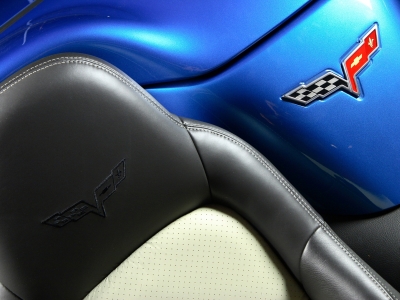Recent Articles
Popular Makes
Body Types
2008 Chevrolet Corvette Convertible
More power, more refinement, and better than ever
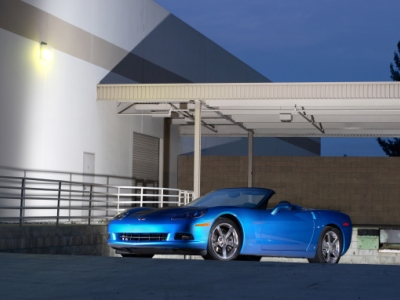
– The quintessential American sports car gets significant updates for the 2008 model year. A bigger engine, an all-new steering rack, an upgraded automatic transmission and an optional exhaust upgrade enhance performance, while a new leather-wrapped dash significantly adds to the Corvette’s feeling of refinement.
– Chevrolet is serious about its sports car and is addressing longstanding criticisms regarding its refinement and character against cars like the Porsche 911. With this model, the company has seriously upped the ante, making the Corvette desirable beyond its current loyal fan base.
There are two Chevrolet Corvettes. The first is as the quintessential American sports car, as classically Yankee as baseball and apple pie. It exudes power and performance from every angle. The engine’s idle is a basso profundo note that you feel as much as you hear, and it pours out power and torque as thick and sweet as an overturned jar of honey. The handling will have your neck muscles straining. Yet all of it at a price thousands less than anything else that can approach the kind of performance Chevy’s sports car muscles up.
Then there’s the other Corvette, the one Chevrolet and the car’s legions of fans would rather you forget. The one with the plasticky interior, junky build quality and poor reliability. The one that became synonymous with gold-chain wearing mid-life crisis guys and the trophy wives who love them. The one that Porsche drivers laugh at because they know that deep down inside, the Corvette is just another product from GM and will never be as purebred as a 911.
Chevrolet of course promotes the former image, but is keenly aware of the latter and over the past decade has worked hard to erase it from buyers’ minds. The fifth generation “C5” Corvette that lasted from 1998 through 2003 indeed changed a lot of minds, but not enough. The current generation C6 has gone even further, refining the Vette without filtering the driving experience.
The 2008 model year brings us a significant host of updates to the current car, enough that we want to call it a C6.5. On the surface, it looks much the same as the 2007 model, yet Chevrolet has put money where it counts, improving on the stuff that makes the Corvette great, and addressing the areas that make Porsche owners point and laugh. The steering feel is greatly improved thanks to a new mechanism. The automatic transmission offers up a more involving driving experience. An optional leather-wrapped dash is as nice as anything we’ve seen from Stuttgart. There’s even a new engine with even more power. It’s still not perfect, but Chevrolet’s sports car is better than ever, able to hold its head high against its rivals in both performance and refinement.
Page 2
In addition to improvements to the drivetrain, the Chevrolet Corvette sports several other changes for the 2008 model year, most of which center on improving the car’s refinement.
The centerpiece is the new optional leather-trimmed dash. This is a seriously nice addition to the Corvette’s interior, which otherwise is awash in hard and cheap-feeling plastic. The leather covers this up, with straight seams, two-tone in either our car’s Linen or a darker Sienna color, and with “Corvette” embroidered above the glovebox. The leather trim is also on the doors and the driver’s side of the center console. All models get a few new interior trim pieces, including a new “Cyber” patterned center console trim. Keyless entry and ignition is standard, as are luxury features such as OnStar and XM satellite radio, auto-dimming mirrors and an iPod/MP3 jack on all vehicles except those with a navigation system.
Outside, split-spoke cast aluminum wheels are standard, while forged aluminum wheels are optional. Two new colors are also available: our car’s Jetstream Blue Metallic or Crystal Red.
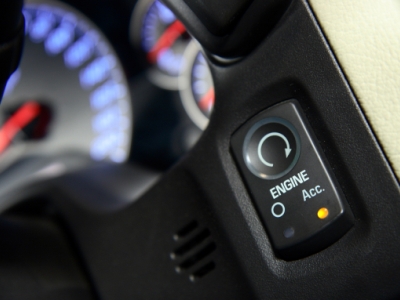
Page 3
There are two basic models of Corvette, with two more special edition ones thrown on top. The basic Coupe and Convertible are available with the 430-horsepower 6.2-liter V-8 engine and a six-speed manual, starting at $46,820 for the coupe and $55,160 for the convertible, including the $825 destination charge.
Options packages for the two cars are similar, and our test car – a Jetstream Blue convertible – was loaded. In addition to the standard stuff like power leather seats, the keyless entry with pushbutton start and dual-zone automatic climate control, our car came with the $1,250 automatic transmission and $395 performance axle ratio, a new combination for 2008. On top of that, it had $1,295 worth of polished aluminum wheels and a $1,750 DVD-based navigation system. The paint itself was $750, and the magnetic ride control added driver-selectable suspension settings, larger cross-drilled brakes and another $1,995. The whopper was the $8,600 Premium Equipment group, which included a head-up display, power telescoping steering wheel, heated seats with position memory, universal garage door remote, steering wheel radio controls and a power convertible top. It’s also the only way to get that cool leather-wrapped interior. Sum it all up and you’ve thrown $16,035 in options on our test car, for a grand total of $70,370. The only option our car lacked was the $1,195 exhaust system.
The first special edition Corvette is the Z06, which features a 7.0-liter V-8 engine making 505 horsepower. Available only with a manual transmission, this high-performance beast also features a more aggressive suspension. The performance hardware is already there, leaving options more or less the same as the standard Corvette, with the premium package coming in at $6,545 over the “base” trim’s $72,125 price tag.
The second special edition represents Chevrolet’s bid to return the Corvette to the top of the world’s sports car heap: The ZR1. It houses a supercharged 6.2-liter V-8 engine packing at least 620 horsepower and enough suspension and body enhancements to truly make it king of the hill. The car isn’t on sale yet, and prices and trim levels haven’t been announced, but expect the ZR1 to come in around the $100,000 mark.
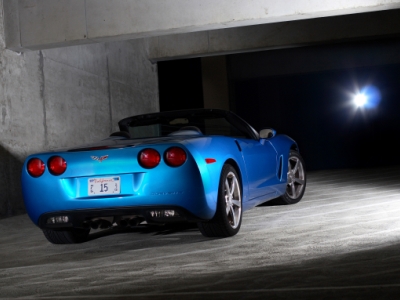
Page 4
As mid-cycle refreshes go, this one is pretty good, even if many of the changes aren’t noticeable to the naked eye. Pop the hood and you see improvement number one: the enhanced LS3 V-8 engine. Now at 6.2 liters of displacement, the new V-8 is rated at 430 horsepower and 424 lb.-ft. of torque thanks to new heads, an upgraded valvetrain, better intake manifold and a few other tweaks. A new dual-mode exhaust system is a $1,195 option, and ups power to 436 horses and torque to 428 lb.-ft.
Connected to this engine in our test car was Chevrolet’s new six-speed automatic transmission, which sports two important improvements for 2008. First, shift speed in the manual mode is improved, giving automatic-equipped cars a sportier feel and drivers better control. Second, the 2.73 performance axle ratio is now available on the automatic, giving the cars so equipped even sharper response off the line.
The Magnetic Ride Control on our test car lets drivers select between a Tour and Sport mode with a large dial on the center console. In practice, we felt little difference between the two on the road; even on rough pavement, the ride didn’t diminish significantly in Sport mode. The difference on a twisty mountain road is also hard to discern; to fully exploit this car’s dynamics, it needs to be on the relatively safe environment of a racetrack.
One expects a loose structure in a convertible, but the Corvette is amazingly stiff. This is thanks to a beefy structure that includes super-strong hydroformed frame rails. It also allows the Corvette’s suspension to do a better job of keeping the car planted on the road, rather than accommodating a flimsy chassis. As is tradition, the Corvette’s exterior panels are a lightweight composite, contributing to the car’s 3,246-pound curb weight.
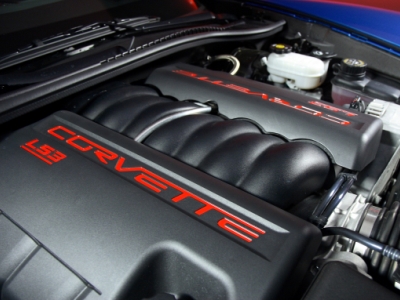
Page 5
The Corvette is special from the moment you open the door. The new keyless entry means you keep the fancy fob in your pocket; just grab the little rubber pad behind the door and pull. Sit down (and we mean down) into the comfortable but flimsy-feeling seat, grab the meaty wheel with one hand and push the start button. The Corvette roars to life and quickly settles into a comfortable burble at idle. Loping there, the Corvette has just a hint of engine shake, reminding you that there’s a living, breathing monster under the hood.
Reach up, unhook the top latch, give it a quick push and then reach behind the wheel to press the button that drops the top. It takes a mere 20 seconds, letting in the sunshine and eliminating the top’s thick pillars. It also lets in more of that deep, barrel-chested idle rumble.
Slipping the Corvette into drive lurches the car just a little, but it’s sweet and smooth in traffic. Seriously, your grandmother could drive this car (as long as she could see over the doors and dash) and not be intimidated by it. The transmission shifts smoothly, the engine is quiet, and even the ride is comfortable. Take it up on the freeway with the top down and your hair will get mussed, but not too badly. With the windows up there’s a calm pocket of air in the Corvette that lets the heater keep things comfortable, even when temperatures drop into the 50s. All in all, a pleasant car for a leisurely Saturday afternoon cruise.
Then you floor it, and all hell breaks loose.
The transmission – which had been letting the engine turn about 1,500 rpm in sixth on the freeway – suddenly drops three gears. The engine roars to redline, you’re pinned in your seat, and the numbers on the digital head-up display cast on the windshield begin cycling up by fives and tens. Suddenly a “1” appears before the numbers – you’re into triple digits – and only your good sense and absolute fear of getting thrown in jail for excessive speed get your foot off the gas. The power available in the standard Corvette is astounding, enough to make you wonder who drove it and decided that 505 horsepower and 620-plus horsepower versions were needed.
But the Corvette is far from a straight-line specialist. The suspension is taut in corners, and if you hit bumps the car skids disconcertingly, but the grip from the big Goodyear tires is tremendous, and the low stance makes it easy to toss the Corvette back and forth on a twisty road. The new steering mechanism makes you feel much more connected to the car than ever before. It’s still not as accurate or effortless as a Porsche, but it’s a far cry from where it once was and makes the Vette easier to drive even faster. The car’s stability control has three modes. The standard mode keeps everything on, giving you enough slide to kick the tail out a bit, but reigning you in before you get in trouble. Shut off traction control and you get more room to play, but the car won’t try to save you if you get in over your head. Then there’s the Competitive Driving mode, which leaves on the car’s Active Handling – a high-performance version of stability control – but shuts off traction control for those times you want to do big nasty wheel-smoking burnouts. Or, y’know, slide the rear end a little more.
Since we didn’t have a chance to evaluate our test car on a track, we left the traction control on during our evaluation, and found it unobtrusive and, frankly, a welcome leash on our activities. Not that the Corvette is hard to drive fast; quite the opposite is true, and its deceptively benign nature makes it easy to get in over your head. In other words, dump the whole gold-chain and trophy-wife image of this car: Even with an automatic transmission it’s a serious performance machine, one that rewards good drivers and gladly punishes the stupid ones.
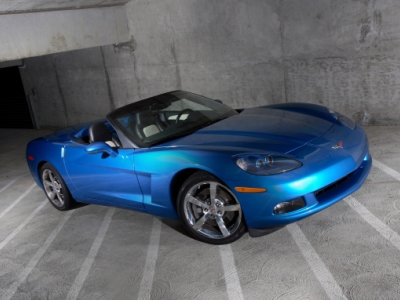
Page 6
The Corvette’s interior is awash in oxymorons. Take the seats for example. They’re surprisingly comfortable, with good support from all directions. The leather is perforated, but feels solid if not Lexus-buttery. Yet for all their comfort and support, they still feel a little flimsy, lacking the solidity you find in other high-end sports cars like Porsches. Also, we wonder why in a $70,000 car the seatback adjustment is manual. Heck, we could even live with that if the handle didn’t feel like it was about to snap off.
Despite this, we found ourselves easily acclimating to the Corvette’s interior. There’s plenty of leg room and head room, even with the top up. Despite the close-coupled design, there’s good arm and shoulder room, too. The only downside is that the window sill is high, so if you’re in the habit of resting your arm there, well, just hope you’re really tall. However, the steering wheel – which oddly features power telescoping but manual tilt adjustment – is perfectly sized and wrapped in soft, smooth leather, and you really don’t want to take your hands off it for a moment.

Page 7
It is very possible that 40 years from now this generation of Corvette will be looked upon with the same fondness and nostalgia that we have for the 60s-era coupes and convertibles. This is a beautifully styled car, with not a line out of place. The fenders swell over the wheels in the front and rear, but gently, not cartoonishly. The wheels themselves are perfect five-spokes, showing off the big cross-drilled brakes behind them. Those fender vents are real, and they glide into strakes along the flanks of the car that recall Corvettes of the past, but don’t copy them outright. In fact, the entire car is a study in the best way to keep a car’s heritage alive without resorting to retro styling gimmicks: The 2008 car is instantly recognizable as a Corvette, yet it doesn’t look anything like its classic predecessors.
The same is true of the interior. There are echoes of Corvettes past in the twin-cowl design, but it’s thoroughly modern inside. The gauges seem to float in midair at night, and that 200-mph upper limit on the speedometer isn’t far from the truth; Chevy predicts about 190 mph. The waterfall of body-color composite between the seats recalls the 50s Corvettes, when all of them were convertibles. The new leather on the dash and elsewhere dresses up the interior significantly, and we love the two-tone look.
Of course, that’s just what your eyeballs tell you. The day-to-day usefulness of the Corvette is another story, and surprisingly, it’s mostly a good one. We’ve already mentioned the comfortable ride and pussycat behavior the car displays in-town. We didn’t mention the interior storage space. There are useful door pockets, two cup holders hidden by a sliding door, and an ample center console bin that makes up for its shallowness by being quite long. The glovebox is small and largely taken up by the owner’s information package. For a commuter by herself it’s fine; for two people and their junk on a weekend, there’s enough space here to get by, but just barely.
Pop the trunk and you’ll find 11 cubic feet of storage space with the top up, and it’s long and flat enough to be useful as well. Throw in a couple sets of golf clubs for a day on the links, or a couple of overnight bags for a weekend getaway, and you’ll have room to spare. Top down it shrinks to 7.5 cubic feet, which isn’t great, but still good enough if you pack lightly. The only downside is the tremendously high liftover, since you need to clear the entire rear bumper cover before accessing the trunk. It also took a good hard slam to shut properly; it’s annoying, but something to which we quickly grew accustomed.
Ergonomics in the Corvette are well thought out for the most part, but there were a few switches scattered here and there that we thought were oddly placed. For example, the toggle to operate the power top was hidden behind the steering wheel, while the button for the traction control was on the center console; some of us thought they should be reversed. We did like the head-up display, and note that it’s the only way to see what gear you’re in when in the automatic’s manual mode, but we found ourselves fiddling with the brightness control more than expected. It also washes out completely in bright sunlight, and the housing itself is too often gracelessly reflected in the windshield.
It should come as no surprise that the Corvette is not the quietest car to come out of GM. Whether this is a good or bad thing depends on your point of view. We like the sounds the Corvette makes, and we suspect most people in the market for this car will agree that the roar of the V-8, the growl of the exhaust, and the rumble of the big tires on pavement is all part of the experience. On the other hand, there are times when you want to be alone with your thoughts, and those same sounds can get in the way of navel contemplation. Some of what we heard was a little disappointing, like the squeak of the driver’s door in its frame; it wasn’t constant, but it was clearly audible over harsher road surfaces.
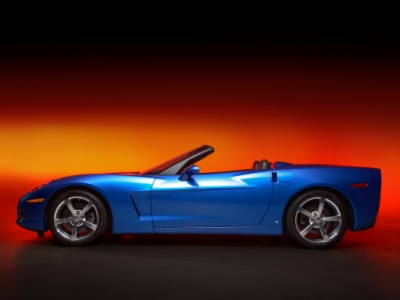
Page 8
Quality is one of the areas where Corvettes have, unfortunately, often lagged their competitors. Chevrolet has stepped up its game, and Corvettes have fewer mechanical problems than they once did according to the companies that track that sort of thing. But we’re more interested in the subjective side of quality.
On that front, the new interior treatment goes a long way toward making the Corvette a world-class place to inhabit. The leather is soft and supple, the seams are straight (for the most part, we did find one minor wobble), and the two-tone treatment looks really good. Unfortunately, much of the remaining exposed plastic isn’t very nice to the touch, feeling hard and unyielding to the fingertips. The glovebox door especially felt cheap.
The rest of the materials are largely on the better end of the scale. Most of the remaining plastics were high enough quality to merit placement in a $70,000 car, and the rest of the switchgear felt worthy of the car’s price tag. Rather than a traditional handle, the Corvette uses buttons to open the doors; they’re a little gimmicky at first, but they work well enough and after a short time we decided we liked them after all.
Assembly quality in our test Corvette was remarkably improved over earlier versions. Panel gaps were tight and straight inside, and even the gap between the doors and dash was admirably small. Outside it was much the same, but the composite panels tend to expand and shrink in heat and cold, so exterior gaps were larger than we prefer, although they were straight.
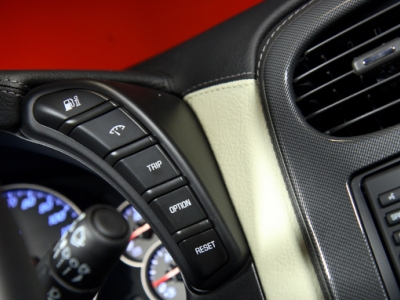
Page 9
There are many cars that compete with the Corvette, especially considering its expansive price range. On the lower end of the scale you have loaded Nissan 350Zs and Infiniti G37 coupes, and on the high end you have Dodge Vipers and BMW M Roadsters.
Historically though, the classic match up is between the Corvette and the Porsche 911. They came into being at about the same time, and have been competitors on the streets, showrooms and on the racetrack for more than four decades. Corvette fans love their cars with the same passion and fervor as do Porsche lovers, and their fierce loyalty is often borne out with derision for their competitors.
The Corvette has made its greatest strides in refinement, traditionally the area where the Chevy gave up the most to the Porsche. Dynamically, the two are closer together than ever before, and while the 911 still has an edge in most areas – except for outright raw power – the edge is dulled considerably. Which is the better sports car? It’s too close to call, but the Corvette’s price advantage, which even at $70,000 is thousands less than a comparably equipped Porsche 911, continues to give it an edge to the uncommitted buyer.
Compared to other cars, it’s still a tossup. While a fully-loaded Corvette is considerably pricier than a Nissan 350Z, the less expensive versions are much closer in price, and the performance advantage of the Vette over the Z is considerable. On the other end, the Dodge Viper is more powerful and faster, but much more difficult to live with than the easygoing Chevy.
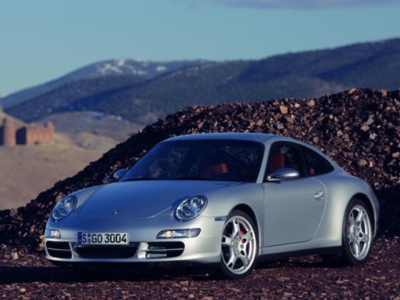
Page 10
Being the son of an automotive journalist, my boy is a bit spoiled when it comes to the excitement of a new car. He’s used to being picked up from school and climbing into a different car every other day. He has been in quite a variety, from the most basic of compacts to $100K-plus luxury sedans, and has pretty much liked them all. But he’s seven-years-old, so his requirements are simple: a DVD player, a navigation system, and speed. That’s not to say he doesn’t know what he likes. The first car he could readily identify on his own without any prodding from dear old dad was a 1963 split window Chevrolet Corvette. Yeah, I say that with pride.
With the long work day over, sometimes the last thing I want to do is spend my evening evaluating a test car. Sure I’m always excited about the opportunity, but there are times when chilling out on the couch with my dog sounds much more enjoyable. It just happened to be one of those nights when I got the keys to our 2008 Chevy Corvette Convertible tester. What a dilemma – sack out at home to my heart’s content or suck it up and stretch the legs of a 430-horsepower sports car.
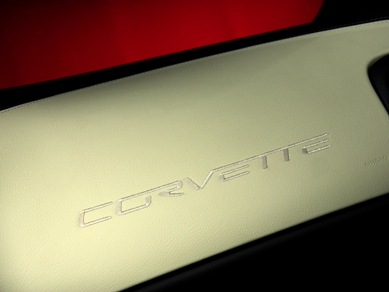
Page 11
2008 Chevrolet Corvette Convertible $70,370 6.2-liter V-8 430 hp @ 5,900 rpm 424 lb.-ft. @ 4,600 rpm Six-speed automatic with manual shift control 3,246 15/25 mpg 17.1 mpg 174.6 inches 72.6 inches 105.7 inches 49.0 inches 43 inches 38 inches Two 11 cu. ft. (top up)/7.5 cu. ft. (top down)
By Keith Buglewicz Photo credit: Oliver Bentley
